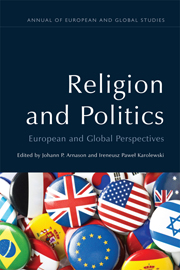Book contents
- Frontmatter
- Contents
- 1 Introduction
- 2 The Religio-political Nexus: Historical and Comparative Reflections
- 3 Politics and Religion in a Global Age
- 4 Comparative Secularisms and the Politics of Modernity
- 5 Europe in the Global Rise of Religious Nationalism
- 6 The European Union's Civil Religion in the Making?
- 7 Democracy, Secularism and Islam in Turkey
- 8 Orthodox Religion and Politics in Post-Soviet Russia
- 9 Religion and Politics, Church and State in Chinese History
- 10 Religion and the State in Contemporary Japan
- 11 Arab Revolutions and Political Islam: A Structural Approach
- 12 Beyond Post-secularism: Religion in Political Analysis (Review Article)
- Notes on the Contributors
- Index
9 - Religion and Politics, Church and State in Chinese History
Published online by Cambridge University Press: 05 September 2014
- Frontmatter
- Contents
- 1 Introduction
- 2 The Religio-political Nexus: Historical and Comparative Reflections
- 3 Politics and Religion in a Global Age
- 4 Comparative Secularisms and the Politics of Modernity
- 5 Europe in the Global Rise of Religious Nationalism
- 6 The European Union's Civil Religion in the Making?
- 7 Democracy, Secularism and Islam in Turkey
- 8 Orthodox Religion and Politics in Post-Soviet Russia
- 9 Religion and Politics, Church and State in Chinese History
- 10 Religion and the State in Contemporary Japan
- 11 Arab Revolutions and Political Islam: A Structural Approach
- 12 Beyond Post-secularism: Religion in Political Analysis (Review Article)
- Notes on the Contributors
- Index
Summary
When I began to study Chinese history in 1968, the standard understanding was that China had no native religion, that Confucianism was not a religion, and that Buddhism, a religion of foreign origin, had long since gone into terminal decline. Studies over the last half century have demonstrated that, on the contrary, there was a native religion, Daoism, Confucianism was a religion, and Buddhism has continued to thrive right down to the present. Together, these ‘three teachings’ (sanjiao) as they were called in Chinese received ongoing state support throughout imperial history (220 BCE–1911 CE). Often, moreover, they would band together to oppose a fourth form of religion, one founded on mediums (wu) who spoke for the gods enshrined in local temples. To be complete, a history of Chinese religion must therefore describe these four religions and their interactions. What such a description would lead us to discover is that the ultimate arbiter between these four religions was the state itself. Headed by a Son of Heaven who possessed the Mandate of Heaven to rule, the state in fact functioned like a church. That is, there is nothing really comparable in Chinese history to a conflict between church and state because the Chinese state was a church-state.
To explain what this affirmation means in concrete historical terms, we must begin with Confucianism, for it is chronologically speaking the first of the three teachings to emerge. Confucius (551–479 BCE) himself had no intention of founding a religion.
- Type
- Chapter
- Information
- Religion and PoliticsEuropean and Global Perspectives, pp. 157 - 167Publisher: Edinburgh University PressPrint publication year: 2014



